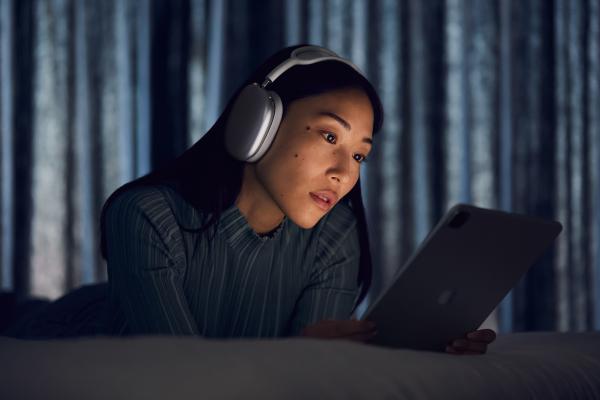Hands on: Apple Spatial Audio and AirPods Max

Spatial Audio is not exactly new to Apple as 3D sound was added to video playback last year. Apple and Beats headphones use algorithms to map sounds to specific locations as if speakers were set up around you. Audio filters are used to adjust the levels and frequencies for each ear to give a sense of distance and discrete placement. It’s a natural idea for surround sound video.
When applied to music, Spatial Audio has the effect of expanding the soundstage. Instruments and vocals are better separated, easier to identify. It adds musicality and emotion to a song and boosts the perceived quality of the headphones. It all sounds a little more realistic, as if you are there in the studio listening to the performance.
Apple designed the AirPods Max to showcase the updated higher-quality Apple Music. These over-ear headphones are designed and made by Apple and are not a part of the Beats division. The idea was to take the connectivity and features of the in-ear AirPods for those who prefer over-ear headphones. When evaluating headphone design, the company wanted to reimagine every aspect of over-ears. Perhaps the attention to design and detail justifies the $550 price tag.
Several design features focus on comfort. The headband is made of wide, coated steel mesh. It’s flexible and light, so it doesn’t put pressure on the top of your head. The connection to the ear cups also adapts easily to the shape of your head and ears. Anodized aluminum ear cups with (removable) memory foam cushions further the comfort and fit, resulting in headphones that you can wear for more extended periods and deliver sound to your ears even if you wear glasses or earrings. There were no serious pressure points when I was testing, but I’m sensitive to wearing over-the-ear 'phones and got tired after a couple of hours. Still, it may have more to do with my ill-fitting glasses.
Much attention was given to the design of the sound delivery, using higher quality materials and features that better reproduce the higher-quality music. For example, the headphones have dual neodymium ring magnets for power efficiency. In addition, Apple designed their own 40 mm dynamic driver and created a vent system around the voice coil and through the bass port to allow air to flow freely, allowing for improved clarity.
The hardware design is combined with Computational Audio processed with a pair of Apple H1 10-core chips. Four microphones in each ear measure sound frequencies, then Adaptive EQ adjusts the low and mid frequencies in real-time. The result is good sound at any volume level. Spatial Audio takes advantage of these design features. Together, AirPods Max and Spatial Audio create a more enjoyable music experience.
Expanding the Soundstage
When Spatial Audio is turned on, the soundstage expands. Instruments and vocals are not only placed in a specific “space” around you; they become clearer and easier to identify. The effect is more pronounced in newer music. Billie Eilish’s "Therefore I Am" has more separation and clarity than "Angie" by the Rolling Stones. While some (not all) older re-mastered songs still have more separation than previous versions, the original analog format is detectable. Still, it does add some of that old vinyl presence. The drums were very clean in "Tom Sawyer" by Rush and the sound panned across my forehead. I heard guitar riffs and instruments that I’d never noticed in the Jackson 5’s "I Want You Back."
When using Apple or Beats headphones, the default setting switches automatically to Dolby Atmos. To engage Dolby Atmos on other brands or wired headphones, you must go to settings, then music, and choose “Always On” for Dolby Atmos. I was switching between different headphones, so I had it set to Always On. But I noticed a strange phenomenon: When a Spatial Audio song came on, the sound was markedly quiet and muddy. Turning off Dolby Atmos raised the volume and boosted the separation and clarity. What’s even stranger, it had the opposite effect on the older recordings. Turning on Dolby Atmos with Spatial Audio would brighten the sound. Apple is looking into the cause.
Spatial Audio is especially impressive when listening to surround sound video. Any videos with 5.1 or 7.1 surround sound or Dolby Atmos will play in Spatial Audio. The head detection is more evident with video soundtracks than music. Using the accelerometer and gyroscopes in the headphones in relation to the iPad or iPhone you are watching, the sound continues to come from the direction of the screen even if you turn your head.
Starting this fall, Apple TV will also have Spatial Audio capabilities for use with the AirPods Max. Once it is established that you are looking at the TV, the speaker “placement” will be oriented to that direction. The sound will continue to come from that configuration even if you move about the room or turn your head. The Apple TV and AirPods Max will detect if you walk out of the room and adjust the sound accordingly. You’ll have to reestablish looking at the TV screen when you return. If Spatial Audio works as well as with mobile devices, listening to the Apple TV with AirPods Max will feel like a complete theater experience.
In the early days of surround sound, I used the opera singer scene in The Fifth Element to demonstrate the separation of sound and effects. That same discrete separation was apparent when listening with the AirPods Max. Listening to the Apple TV original For All Mankind, the effect of Spatial Audio was so true to life on these headphones that it was like sitting in a movie theater. The room felt huge. When the sound stayed in the same location as I moved around and turned my head, I knew I was listening on headphones, but I could have sworn that the sound was from speakers filling the room. I even lifted the headphones to be sure.
Seamless Transitions and Getting Rid of Noise
The AirPods Max is designed to work seamlessly with Apple devices. When I lifted the headphones away from my ears, the video or music would pause. If I put them on my desk, the accelerometer noted that they were inert and put them in ultra low power mode. AirPods Max will play for 20 hours on a full charge. A quick 5-minute charge will give you an hour and a half of play time.
The headphones were quick to switch between listening to my iPad to my iPhone (and vice versa). With the automatic connection setting enabled, I simply had to stop playback on the first device then start it on the second. Sometimes it would take a minute after tapping play on the second device, but it usually did switch on its own. Likewise, the headphones were detected on my Mac, and I could click quickly switch and connect.
Two buttons on the right earpiece control the headphones. Like that on the Apple Watch, a digital crown can be turned to raise/lower the volume. A quick press will play/pause. Double press to skip to the next song, and triple press will go back to the previous song. A long press will bring up Siri, where you can ask for a specific song, album, playlist, or artist, or send a message and perform other Siri functions. Siri is also available by speaking “Hey Siri.” The second button switches between transparency (you can hear outside sound) and noise cancellation modes.
The active noise cancellation on the AirPods Max is outstanding. When I pressed the button, a high-speed fan sitting next to me fell silent. I had to toggle a few times to be sure it was still running. The noise cancellation is achieved through eight microphones. The H1 chip analyzes the audio data and adapts in real-time—200 times per second. The extreme isolation adds to the sense that you are sitting in the room with music when listening to Spatial Audio.
Some audio purists have argued that the new Spatial Audio mix isn’t true to the artist’s vision in original older recordings. Still, if you don’t like the way it sounds, you can quickly turn off Spatial Audio in the control center on your mobile device.
Apple Music’s other new feature is lossless and high-res audio. As lossless/high-res requires bandwidth that is not possible via Bluetooth, it doesn’t work with the AirPods Max. I tested the lossless audio and Dolby Atmos with Sennheiser’s IE 900, high-end wired in-ear monitors. In my next column, I’ll write about my experience with Apple Music and the Sennheisers.






























































